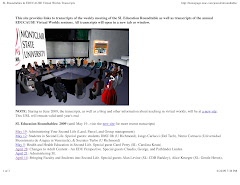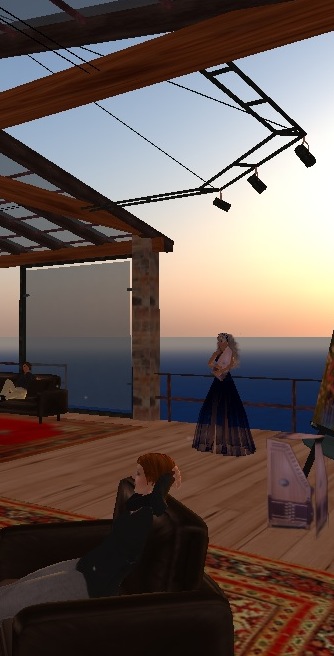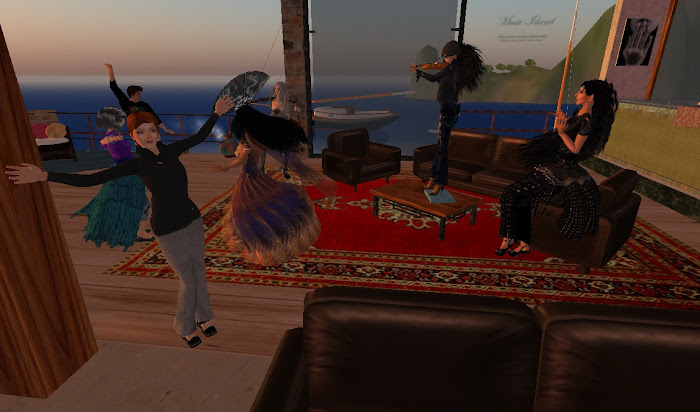===
There are two points I want to demonstrate in this talk:
(1) users like "worn" tools because through practice use and play they come to own them -- cutting edge tools appear to belong to their experts.
(2) a transdisciplinary feminist practice uses demonstration and narrative to create a double consciousness that does not privilege expertise and membership over peripheral participation (or learning and play) -- this is one element of what I call "scoping and scaling"....
===
 ===
===This graphic -- and some of the others -- are links.... Click to see which ones....
===
Well, I found the first part of my title for this talk in the online virtual world Second Life. Are social media virtual worlds? was the question asked last Thursday in the community forum that follows up from one of my currently favorite TV shows, called Metanomics. You can watch the show in its machinima form on the web as well as participate in its live taping on Wednesdays at the studio in Second Life.
The second part of my title, “getting at cognitive sensation” comes out of the revisions of my current book manuscript on networked reenactments. Among other things, it describes linkages between TV and the web coming into being in the nineties as changes in political economy repositioned old and new media within processes of knowledge production. The work I do scopes and scales among systems and infrastructures, to situate immersive practices as repurposing cognitive sensation for multiple commercial media. I draw upon the work of feminist technoscience theorists Leigh Star, Lucy Suchman and Donna Haraway for tools for such analysis.
But first, to give you a feel for what cognitive sensation is about, I plan to tell a couple of stories about Second Life, as a very nexus of social media, and I hope, thus to share some of its real fun as well. Fun, play, and doing what seems “easier,” for lack of a better term, is part of what I want to explore in this paper. So, maybe not so coincidently, my relaxation time after the daily work on a book in many ways about television, hasn’t been spent watching television, but instead socializing, and even researching and learning how to teach in Second Life. And there, recently, I had an ah-ha experience.
===
Ah-ha! Experiences!
• play, double consciousness, literalizing fantasy
 ===
===It was right after my first in-world class for an online course on teaching in SL. I was going through the inventory of teaching gadgets that the instructor had given us, trying them out and imagining how to use them next Fall in this oddly metaphors-made-real virtual teaching environment. All of a sudden, I had an uncanny and doubled sensation of rezzing these peculiar gadgets, that is, making them appear and readying them for use, as if I were me as my avatar in both my First and Second Life classrooms at the same time. That double consciousness we call “play” was momentarily quite visceral. As if aware of the very “hormones coursing through my veins” I experienced cognitive sensations that felt utterly embodied, and experienced my worlds of teaching as simultaneously superimposed in tandem. The sensation was so intense that just describing it I feel again a bit of its echoing bodily frisson.
This makes two striking ah-ha moments in my playing around during my sabbatical in Second Life. I will tell you about the other in a moment, but just to keep some connections to blogging clear, I have to say that the one I’ve just recounted reminded me of an another essentially similar feeling. It was the reason I had for turning away from our university supported Learning Management System, to use Blogger instead, for classes or for presentations. It is a sensation that I have only able to describe as easier. What in the world does easier mean here? It certainly doesn’t mean less work or less time or less involving proprietary services. This is a paradoxical point to take up, and considering some of these immersive venues, and some patterns among sensations, cognitions and feminist transdisciplinary practices, help us to link these experiences.
===
• multiple channels, cognitive sensations
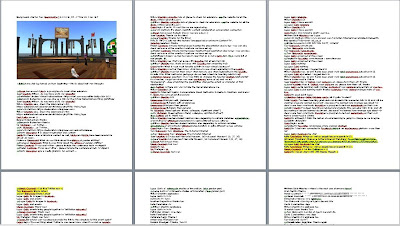

===
But let me tell you about the second ah-ha experience then. Actually that experience really was the first one, it took place in the first couple of weeks after I registered for Second Life. I luckily landed in SL right in time for a Virtual Worlds for educators’ conference, and so lots of events were all set up for folks who, like me, had never played in a virtual world before. Social groups for educators were lively and welcoming. I had already learned to move my avatar around by the time the conference started, aided a bit by some very recent and very introductory experience playing Lara Croft Tomb Raider.
An opening keynote for the conference was presented by Tom Boellstorff, whose queer anthropologies of Indonesia I have been using in writing and teaching for at least a decade. From 2005-2007 as Tom Bukowski he conducted ethnographic fieldwork in Second Life and last year published Coming of Age in Second Life. His avatar sat on a speaking platform and he gave the live talk using a mic on his computer, the audience hearing it over their own computers’ sound systems. Visually, the ambiance was a bit surreal: the speaking venue was located in a fantasy sim, a 3D simulation created on one of Linden Lab’s 4000 odd servers in either San Francisco or Dallas. What was at that time new to me was the text chat going on at the same time Boellstorff was presenting. All the folks gathered were continuously talking in text during the voice presentation, some just saying hi to their friends and offering local personal comments, but most otherwise engaging its content in massively divergent ways. And Boellsdorff himself was reading the text chat on and off as he talked, replying to it both vocally and in the text stream too, a kind of multi-tasking that utterly amazed me.
When I first logged on to SL, I asked around about it. Several folks said to me that they found the empty sims of Second Life a bit sad. I took from this the idea that once these had been vibrant and full, but now were no longer. With this in mind as I walked the streets of various showcase simulations, usually one of a very few avatars in range, I felt an odd loneliness. Yet at the same time, these so-called empty spaces could occupy me for the hours I no longer spent watching television in the evening. These spaces were very absorbing, I spent my time clicking on objects that then gave me notecards and did various things. And playing Tomb Raider hadn’t included other avatars either.
I was at that time revising the sections of my book on what in Science Studies is called Actor-Network theory, and analyzing the crowded exhibit space of Science in American Life at the National Museum of American History. Full of what the political Right considered the wrong kind of things, Science in American Life had been a hot spot for the history, science and culture wars of the nineties I was writing about. Things themselves were players in all this, as Actor-Network theory and one of its creators, Bruno Latour, would rightly predict, being all about non-human as well as human agencies. I had spent a lot of time examining objects there too.
So while Boellsdorff was talking and I was reading the chat stream at the Virtual Worlds conference, I suddenly had another embodied sensation of double consciousness. I thought of how Europeans coming to the Americas thought they were seeing a empty landscape, when in fact it was really quite full of people and civilizations. Some of that was because they didn’t know these when they saw them, they didn’t recognize these as human, as agents like themselves; and some of that was because their biological influence had gone way ahead of their bodies and perceptions, thus creating some of the emptinesses they later encountered. In my first public engagement in Second Life I typed into the chat stream during Boellsdorff’s talk: “things as well as people become agents in SL.” And in and among a whole discussion going on about twitter and facebook and asynchronous and synchronous communication, in the text chat appeared something from Boellsdorff: “Tom Bukowski: Bruno Latour” and then he offered folks his email address.
===
:: PP: /and please share cleaned chatlog?
AO: I feel very connected in Facebook which is an ayschronous platform more than not
LS: facebook has chat
Katie Fenstalker: things as well as people become agents in SL.
Universal Translator: Welcome to the Universal Translator. To configure options type "translator" into public chat. For privacy use channel #777 by typing "/777 translator".
:: LS: facebook has chat
Katie Fenstalker: things as well as people become agents in SL.
MO: A lot like Twitter now :)
AO: i rarely chat in FB with friends though ;)
:: MO: A lot like Twitter now :)
Tom Bukowski: Bruno Latour
:: Tom Bukowski: Bruno Latour
LS: its images in facebook
LS: and events
LS: and events
MO: Thank you!
LS: events bring people together in "affiliation netowrks"
===
I emailed him, introduced myself. We talked about this whole empty/not empty thing. This was my first experience of social networking gone immersive. I’m sure for others it has alternate configurations and inclusions. For me at that moment it included other forms of networking, in this case email and the whole discussions of facebook, twitter and blogging. All of it together made for me an amazing high. I don’t know if it was the dopamine or which neurotransmitter turned hormone kicked in, but this was cognitive sensation in a real rush. And in that rush, I was hooked. I was hooked into Second Life. Other immersive experiences might hook one into something else, say Blogger or Twitter.
===
Communities networking socially
• City Walls?
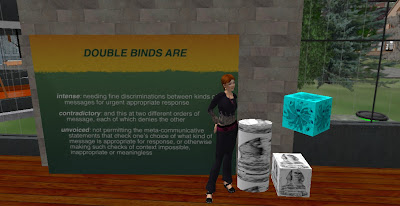 ===
===I use facebook now to immoderately share my pics of SL. One with a poster on double binds I made in preparation for my first talk to be given in Second Life in July. My description of the talk: “Double binds are intense, contradictory and voiceless. They can be found at different ranges of social and conceptual infrastructures in ways we act, think and respond. This is an opportunity for discussing how recognizing double binds might be valuable in a variety of contexts and projects. Katie Fenstalker (King) is sharing a piece of current writing on play, learning and double binds. Ask her for it before hand, or just come with your own interests.”
After seeing this pic current friend, former teacher Donna Haraway emails me back: “Wouldn't it be interesting if city walls looked like this, full of intriguing theoretical/practical thinking and questioning?”
===
• Cedar Island

Jon Seattle (Jonathan Smith, Northwestern University), creating communities
===
My Second Life avatar now lives in a residential community called Cedar Island, and one condition for residence there is to create events or presentations involving intellectual or creative arts projects four times a year. This will be my first contribution. Cedar Island is the literal creation of Jonathan Smith, in SL Jon Seattle, a programmer at Northwestern University who works to develop technology tools for educators. A range of activists, artists, scholars, and other creative types, some with long term IT professional or other connections, are among those governing themselves by consensus at Cedar Island. This local, smallish group experience collects folks from Europe, Latin America, Canada and the US (at least), and twice a week we have both brunch held at 5 am Pacific or Second Life time, to accommodate Europeans, and tea held at 4 pm SL time, to accommodate Western Hemisphere folks.
===
• the Second Life Left Unity Feminist Network
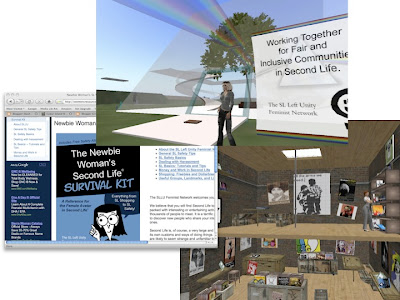
(top) Scylla Rhiadra working on the SLLUFN build for SL's sixth birthday events
===
The SL Left Unity Feminist Network is another example of how social networking in many interlinking small groups has blossomed for me in Second Life. SL is now thoroughly interconnected and overlaps or adds to the social networks I have on Blogger – before mostly intensifying my university associations, or Facebook – adding to that initial reconsolidation and enlivening of friend and family networks.
===
I did find out why the sims in SL are not full of avatars. Linden’s servers can only accommodate about 40 avatars each in addition to all the scripted objects in sims. Sharing a server with a “sea of actants” as Bruno Latour calls gatherings of human and non-human agencies, requires a lot of processes. When you have a big event such as the Virtual Worlds conference, you have to spread the avatars-and-other-object-agents to as many servers as possible. [This turns out to be much more dynamic and less server specific than I have suggested here. Some of what I implied here has both folkloric elements (and thus my reproducing them is an effect of some kinds of membership) and some historical changes on each side of what Linden's servers do and what one's own computer can do. A fascinating discussion is located here. It does also demonstrate to what extent lag figures as a cultural item in SL.]
Otherwise the lag – the dizzying sensation of alternate freezing and moving, seeing and not seeing the 3D graphics – makes for a whole body sick stomach feeling that can outlast one’s computer session. Other platforms fault SL for this, saying that the business model doesn’t allow for scalability. But at the community forum last Wednesday one person remarked that this was not a bug but a feature: in other words, that these effects were desirable. Small groups intensively interacting and generating content are what we mean by social networking, he pointed out.
===
Social networking gone immersive
• Revenue streams
 ===
===And at that Metanomics forum it was clear that no one uses SL in isolation: everyone combines it with many other social networks and technologies. I claimed in the forum that we should be emphasizing the “worlds” part of the question “Are social media virtual worlds?” After all humans are good at generating worlds, and many creative forms across time and cultures might be described by a very extensive use of the term “virtual.” People pointed out all sorts of examples, from cave paintings at Lascaux, to the rituals that turned into staged dramas, to novels, films and tv. Our proliferating knowledge worlds produce a situation of such chaotic fecundity that a variety of understandings termed “transdisciplinary” arise to describe, perhaps attempt to manage both fecundity and worlds.
Marilee Lindeman’s blog site Roxie’s World’s humor and playfulness generates a space both imaginary and real, as ML works as typist for Roxie the dog’s comments on timely events.
===
• Roxie's World/s

===
• play selves: the metacommunication, "This? not"
 ===
===Maybe the word “easy” actually has more to do with all the different somethings now clustered under the term “play.” My former teacher Gregory Bateson, a theorist of play, worked out its double consciousness. As animals and children learn to play they come to know that there are some ways a play self can and must be separated from an everyday self, and they learn to perform this separation in interactive cognitive and social communication forms of “not”: they amuse themselves by performing the communication “this is not it.” The puppy nips, but not hard enough to injure. (Violence? Not.) The teen kisses in Spin the Bottle, but not necessarily the person they like the most. (Sex? Not.) Yet at the same time there are also other ways in which these selves simply are not separated, in certain physiological processes and psychological equivalences. The nip actually hurts a bit, the kissing blush and stammer. A double consciousness of being in both these states at the same time is possible, as Bateson puts it in formal terms, because play creates its own commentary in itself about itself as an intense and pleasurable interactive dynamism – communicatively social, as well as neurological and hormonal. Such metacommunications – or communications about communication – are performed by embodied selves at multiple “levels” of organic and social system, some sequentially, some simultaneously.
===
• Gregory Bateson and daughter Nora, 1970s

===
• Katie Salen's Institute of Play
 ===
===Game designers Katie Salen and Eric Zimmerman point out that when Bateson explained his theory of metacommunication in logically formal terms he deliberately chose to use in his examples intense and “emotional statements about love and hate” [or we could say, non-pejoratively, sex and violence]. These address “the emotional and social realities games reflect and construct. The metacommunicative state of mind is deeply intertwined with the unique pleasures and experiences of play.” Intertwined, yes certainly, and together with pleasures are intertwined an entire range of affects and experiences: frustration and anger, for example, can tip over into violence in play. An entire range of products and effects in gaming even depends upon this double consciousness of “violence? Not” – “sex? Not” – “reality? Not.” Play is all about this edge of discrimination, and about the shifting of context that makes it meaningful.
So what is it with being easier? Well, I’ve come to speculate that what makes it easier for me to use Blogger for teaching or presentations, and to enjoy hanging out in Second Life, has to do with the practice elements of play and fun. At the same time I also cannot help but notice a range of recursive patterns that link transdisciplinary knowledge worlds, life under academic capitalism, and feminist desires for human flourishing coming out in a strangely named emergent posthumanities. This last I share with Donna Haraway in her new book When Species Meet. Scoping and scaling is activity I value, and examining the patterning of patterns is a kind of joking playful intelligence I learned from Gregory Bateson, as in his book Steps to an Ecology of Mind. Both Haraway’s and Bateson’s are books that rescale what might be said to count as digital humanities.
The first lesson I got from playing Lara Croft Tomb Raider was when I finally figured out that learning to move my avatar of Lara around was not something preliminary to the game, but part of the actual game itself. Only if that semi-frustrating, intermittently rewarding experience was itself pleasurable, was itself play, could I work that edge of double consciousness and hormonal rush. I have snarkily claimed that using our campus’ learning management system is like trying to teach in a bathroom. Not only is it inward turning and closed off, functional for privacy in aesthetically minimal ways, but it creates its own world as work, my work and my students’ work. Such Calvinism is not the heart of my pedagogy or my feminism. I do everything I can to avoid it.
Instead Blogger, which can also be aesthetically challenged, rewards me with play. The more I do this thing that is in itself fun, the better I get at it and the more fun it becomes. Are social media virtual worlds? well, they are if their hormonal rushes of immersion allow for a playful double consciousness of distributed embodiments.
===
• transdisciplinary in meta mode:

Photo: Jim Clifford (History of Consciousness); from Donna Haraway's When Species Meet
===
And what about a feminist transdisciplinary posthumanities? Well, on Blogger you can find several versions of arguments I have made about these for particular audiences, complete with pics, quotations and references. But what they boil down to for this talk, is this: we love to create worlds, knowledge worlds among them. We move and travel and alter the edges of these all the time. We inhabit some as members, some as peripheral participants (think Bowker and Star, Sorting Things Out), and to do both, simultaneously, can be another cognitive sensation of, I would claim, world historical importance. A conference like this one is full of worlds. Some may consist, at least here, of only a few members, and their intensive projects may tie them together in clusters of intellectual energy that mandate careful negotiations of meaning and tools. This is one meaning mobilized today for the term transdisciplinary: smallish groups of individuals drawn together from widely varying venues to work closely on collective projects and products that create their community of practice.
I would like to, as Bateson would have said, “meta” that reality to suggest an additional meaning of transdisciplinary. One in which that project self plays in its negotiations on and off with its close character in metacommunications of “not”: “this one thing?” Not. Scoping and scaling out and back as it works an always doubled consciousness, never just disciplinary, or even interdisciplinary, but transdisciplinary as it scales out its multiple worlds. But this also means not being anxious about recursion or vagueness or theory or the abstract or the paradoxical, but working their edges, in interactivities that reflect whole ecologies of mind, where human and non-human species meet.
===




